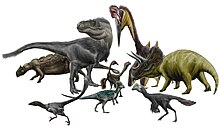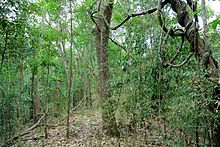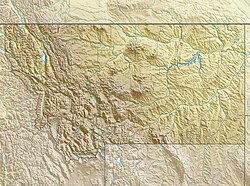Hell Creek Formation
| Hell Creek Formation | ||
|---|---|---|
Ma | ||
Approximate paleocoordinates 52°36′N 74°24′W / 52.6°N 74.4°W | | |
| Region | Montana, North Dakota, South Dakota, Wyoming | |
| Country | United States | |
| Extent | Williston Basin | |
| Type section | ||
| Named for | Hell Creek, Jordan, Montana | |
| Named by | Barnum Brown | |
| Year defined | 1907 | |

The Hell Creek Formation is an intensively studied division of mostly
It is a series of fresh and brackish-water
The world's largest collection of Hell Creek fossils is housed and exhibited at the
Description
The Hell Creek Formation is an intensively studied geological formation of mostly

In 1966, the Hell Creek Fossil Area was designated as a National Natural Landmark by the National Park Service.[5]
Geology

The Hell Creek Formation in Montana overlies the
The K-Pg boundary is generally situated near the contact between the upper Hell Creek and the lower Ludlow member of the Fort Union Formation, though in some areas (e.g. in North Dakota) the boundary is well within the Ludlow Member, 3 metres (9.8 ft) above the boundary with the Hell Creek in some areas.[8] On the other hand, in some small regions of Montana, the Hell Creek Formation contains the K-Pg boundary, and extends slightly into the Paleogene.[9]
The
Paleobiology

The remains of many animals including
Depositional environment

It is a series of fresh and brackish-water
The Hell Creek Formation,
Fossil content
Dinosaurs

A paleo-population study is one of the most difficult of analyses to conduct in field paleontology. Here is the most recent estimate of the proportions of the eight most common dinosaurian families in the Hell Creek Formation, based on detailed field studies by Horner, Goodwin, and Myhrvold (2011)[18]
- Ceratopsidae 40%
- Tyrannosauridae 24%
- Hadrosauridae 20%
- Hypsilophodontidae 8%
- Ornithomimidae 5%
- Ankylosauridae 1%
- Pachycephalosauridae1%
- Troodontidae 1% (represented only by teeth)
- Dromaeosauridae 1% (represented only by teeth)
Outcrops sampled by the Hell Creek Project were divided into three sections: lower, middle and upper slices. The top and bottom sections were the focus of the PLoS One report, and within each portion many remains of Triceratops, Edmontosaurus, and Tyrannosaurus were found. Triceratops was the most common in each section, but Tyrannosaurus was just as common, if not slightly more common, than the hadrosaur Edmontosaurus. In the upper Hell Creek section, for example, the census included twenty two Triceratops, five Tyrannosaurus, and five Edmontosaurus.
The dinosaurs
The dinosaur collections made over the past decade during the Hell Creek Project yielded new information from an improved genus-level collecting schema and robust data set that revealed relative dinosaur abundances that were unexpected, and
Triceratops is by far the most common dinosaur at 40% (n = 72), Tyrannosaurus is second at 24% (n = 44), Edmontosaurus is third at 20% (n = 36), followed by Thescelosaurus at 8% (n = 15), Ornithomimus at 5% (n = 9), and Pachycephalosaurus and Ankylosaurus both at 1% (n = 2) are relatively rare.
Fossil footprints of dinosaurs from the Hell Creek Formation are very rare. As of 2017, there is only one find of a possible Tyrannosaurus rex footprint, dating from 2007 and described a year later.[19] The largest Triceratops skull ever discovered, nicknamed 'Dragon King', was found in Glendive, Montana, which is in the Hell Creek Formation.[20][21]
Eumaniraptorans
Historically, numerous teeth have been attributed to various
Flora

The Hell Creek Formation was a low

The plants of the Hell Creek Formation generally represent angiosperm-dominated
There is evidence of transitional floras in the middle of the Hell Creek Formation as shown by HCII and HCIII zones. The HCII flora represents a transitional period where taxa from the lower Hell Creek are replaced by the HCIII flora. The diversity of the HCIII zone is very high, and its composition is more uniform than that of HCII, many of which were rare or absent from the zones below, and some others that used to be common below became rarer in the HCIII zone. These forms include Elatides longifolia, "Dryophyllum" tennessensis, Liriodendrites bradacii, and many members of the Laurales including Bisonia niemii, "Ficus" planicostata, and Marmarthia trivialis, while "Celastrus" taurenensis, Leepierceia preartocarpoides, and many cupressaceous conifers became rarer. This phenomenon suggests that the global temperature was warming during the last 300,000-500,000 years of the Cretaceous period.[25][26][27][28]
Johnson claims that there are no grasses, oaks, maples, beeches, figs, or willows in the Hell Creek Formation. There is no evidence of fern prairie either.[29] However, there was an extremely high angiosperm diversity — common plane trees, "Dryophyllum" subfalcatum, Leepierceia preartocarpoides, and palm trees — along with extinct cycadeoid Nilssoniocladus, Ginkgo, araucariaceous, podocarpaceous, and cupressaceous conifers. This represents the mixed deciduous and evergreen broad-leaved forest as the Hell Creek landscape. The nature of these forests is uncertain because Johnson found that the majority of the angiosperm and conifer genera are now extinct. He also believes that, very roughly 80% of the terrestrial plant taxa died out in what is now Great Plains at the K-Pg boundary. On other hand, there is a great increase in the abundance of fossil fern spores in the two centimeters of rock that directly overlies the impact fallout layer (the famous K-Pg boundary layer). This increase in fern spore abundance is commonly referred as "the fern spike" (meaning that if the abundance of spores as a function of stratigraphic position were plotted out, the graph would show a spike just above the impact fallout layer).
Many of the modern plant affinities in the Hell Creek Formation (e.g., those with the prefix "aff." or with quotes around the genus name) may not in reality belong to these genera; instead they could be entirely different plants that resemble modern genera. Therefore, there is some question regarding whether the modern Ficus or Juglans, as two examples, actually lived in the Late Cretaceous.
Compared to the rich Hell Creek Formation fossil plant localities of the
Overview (from Johnson, 2002): 302 plant morphotypes based on leaf only, including:
- 1 bryophyte (mosses and liverworts)
- 11 ferns
- 1 sphenopsid
- 10 conifers
- 1 ginkgo (uncommon)
- 278 angiosperms (roughly 92% of all taxa found)
-
Cycads
-
Ginkgo (uncommon)
-
Variousangiosperms
-
Monkey-puzzle leaves
-
Palm treesindicate a hotter paleoclimate
-
Redwoodseed cones
-
Magnolia (common)
- Plants of the Hell Creek Formation
- various ferns and cycadeoids
- Equisetum (Equisetaceae)
- Platyspiroxylon (Cupressaceae)
- Podocarpoxylon (Podocarpaceae)
- Elatocladus (Taxodiaceae)
- Sequoiaxylon (Taxodiaceae)
- Taxodioxylon (Taxodiaceae)
- Araucaria (Araucariaceae)
- Artocarpus (Moraceae)
- Rose family (Rosaceae)
- Cercidiphyllaceae)
- Penosphyllum (Sterculiaceae)
- Laurel family (Lauraceae)
- Magnolia (Magnoliaceae)
- Palms (Arecaceae)
- plane tree (Platanaceae)
See also
- List of fossil sites (with link directory)
- Lists of dinosaur-bearing stratigraphic units
- Morrison Formation
- Cretaceous-Paleogene formations
- Denver Formation
- Ferris Formation
- Lefipán Formation, Argentina
- Lopez de Bertodano Formation, Antarctica
- Tremp Formation, Spain
References
- JSTOR 3515280. Retrieved 13 November 2020.
- ISSN 2076-3263.
- ^ Boswell, Evelyn. "Paradise in Hell Creek". Montana State University. Retrieved 2 April 2007.
- ^ Wilson Lab
- ^ U.S. National Park Service, 1966
- ^ Husson et al. 2011.
- ^ LeCain 2010, p. [page needed].
- ^ a b Pearson et al. 2002.
- ^ Johnson et al., 2002
- ^ DePalma et al. 2019.
- ^ Broad, 2019
- ^ Preston, 2019
- ^ Richardson, T (2008). "Spatial arrangements of fossil species at the Hell Creek formation: Perspectives and conclusions". International Journal of Paleogeology. 12 (24).
- ^ DePalma 2010.
- ^ Lofgren, 1997
- ^ Breithaupt, 1997
- ^ Eberth, 1997
- PMID 21347420.
- ^ Manning, Ott & Falkingham 2008.
- ^ "How a $1.8 million dinosaur skull went from Montana to Hong Kong". 23 April 2015.
- ^ "Yours for US$1.8m or more: 'world's biggest dinosaur' skull on sale in Hong Kong". 25 April 2015.
- ^ Evans, 2013
- .
- ISBN 0-8137-2247-0.
- ^ a b Johnson 1989, p. [page needed].
- ^ ISBN 978-0-8137-2361-7.
- S2CID 4302433.
- hdl:10871/30937.
- .
Bibliography
- General
- Broad, William J.; Chang, Kenneth (2019). "Fossil Site Reveals Day That Meteor Hit Earth and, Maybe, Wiped Out Dinosaurs". The New York Times. Retrieved 1 April 2019. ISSN 0362-4331
- Preston, Douglas (2019). "The Day the Dinosaurs Died". The New Yorker. p. 1. Retrieved 1 April 2019.
- "National Natural Landmarks - National Natural Landmarks (U.S. National Park Service)". U.S. National Park Service. 1966. p. 1. Retrieved 22 March 2019.
- "Hell Creek Project – Wilson Lab". University of Washington. 2017. p. 1. Retrieved 22 March 2019.
- Geology
- DePalma, Robert A.; Smit, Jan; Burnham, David A.; Kuiper, Klaudia; Manning, Phillip L.; Oleinik, Anton; Larson, Peter; Maurrasse, Florentin J.; Vellekoop, Johan; Richards, Mark A.; Gurche, Loren; Alvarez, Walter (23 April 2019). "A seismically induced onshore surge deposit at the KPg boundary, North Dakota". Proceedings of the National Academy of Sciences. 116 (17): 8190–8199. PMID 30936306.
- Evans, D.C.; Larson, D.W.; Currie, P.J. (2013). "A new dromaeosaurid (Dinosauria: Theropoda) with Asian affinities from the latest Cretaceous of North America". S2CID 253638918.
- Husson, D.; Galbrun, B.; Laskar, J.; Hinnov, L.A.; Thibault, N.; Gardin, S.; Locklair, R.E. (2011). "Astronomical calibration of the Maastrichtian (late Cretaceous)". .
- LeCain, Rebecca (2010). Magnetostratigraphy of the Hell Creek and lower Fort Union formations in northeast Montana (Thesis).
- Johnson, K.R.; Nichols, D.J.; Hartman, J.H. (2002). "Hell Creek Formation: A 2001 synthesis. The Hell Creek Formation and the Cretaceous-Tertiary Boundary in the northern Great Plains". Geological Society of America Special Paper. 361: 503–510.
- Johnson, Kirk Richard (1989). A high-resolution megafloral biostratigraphy spanning the Cretaceous-Tertiary boundary in the northern Great Plains (Thesis).
- Paleontology
- DePalma, Robert (2010). "Preliminary Notes on the First Recorded Amber Insects from the Hell Creek Formation" (PDF). The Journal of Paleontological Sciences.
- Boyd, Clint A.; Brown, Caleb M.; Scheetz, Rodney D.; Clarke, Julia A. (2009). "Taxonomic revision of the basal neornithischian taxa Thescelosaurus and Bugenasaura".
- Longrich, N (2008). "A new, large ornithomimid from the Cretaceous Dinosaur Park Formation of Alberta, Canada: Implications for the study of dissociated dinosaur remains".
- Manning, P.L.; Ott, C.; Falkingham, P.L. (2008). "The first tyrannosaurid track from the Hell Creek Formation (Late Cretaceous), Montana, U.S.A". S2CID 129985735.
- New Mexico Museum of Natural History and Science Bulletin. 35: 331–354. Archived from the original (PDF) on 17 July 2011. Retrieved 31 October 2007. Archived 17 July 2011 at the Wayback Machine
- Henderson, M.D.; Peterson, J.E. (2006). "An azhdarchid pterosaur cervical vertebra from the Hell Creek Formation (Maastrichtian) of southeastern Montana" (PDF). S2CID 130751879.
- ISBN 0-520-24209-2.
- Pearson, D.A.; Schaefer, T.; Johnson, K.R.; Nichols, D.J.; Hunter, J.P. (2002). Hartman, Joseph Herbert; Johnson, Kirk R.; Nichols, Douglas J. (eds.). The Hell Creek Formation and the Cretaceous-Tertiary Boundary in the Northern Great Plains: An Integrated Continental Record of the End of the Cretaceous. Geological Society of America. pp. 145–167. ISBN 978-0-8137-2361-7.)
{{cite book}}: CS1 maint: date and year (link - Varricchio, D.J (2001). "Late Cretaceous oviraptorosaur (Theropoda) dinosaurs from Montana". In Carpenter, Kenneth (ed.). Mesozoic Vertebrate Life. Indiana University Press. pp. 42–57. ISBN 978-0-253-33907-2.
- Currie, P.J.; Padian, K. (1997). The Encyclopedia of Dinosaurs. Academic Press. pp. 1–901. ISBN 978-0-122-26810-6. Retrieved 30 March 2020.
- Eberth, D.A. (1997). Edmonton Group. San Diego: Academic Press. pp. 199–204. ISBN 978-0-122-26810-6.
- Lofgren, D.F. (1997). Hell Creek Formation. San Diego: Academic Press. pp. 302–303. ISBN 978-0-122-26810-6.
- Breithaupt, B.H (1997). Lance Formation. San Diego: Academic Press. pp. 394–395. ISBN 978-0-122-26810-6.
- Eberth, D.A. (1997). Edmonton Group. San Diego: Academic Press. pp. 199–204.
- Christophel, D.C. (1976). "Fossil floras from the Smoky Tower locality, Alberta, Canada". Palaeontographica, Abt. B. 157: x.
- Chandrasekharam, A. (1974). "Megafossil flora from the Genesee locality, Alberta, Canada". Palaeontographica, Abt. A. 174: x.
- Estes, R.; Berberian, P. (1970). "Paleoecology of a late Cretaceous vertebrate community from Montana". Breviora. 343: 1.
Further reading
- Bryant, Laurie J. (22 January 1988). "A new genus and species of Amiidae (Holostei; Osteichthyes) from the Late Cretaceous of North America, with comments on the phylogeny of the Amiidae". Journal of Vertebrate Paleontology. 7 (4): 349–361. .
- Archibald, J.D (1982). "A study of Mammalia and geology across the Cretaceous-Tertiary boundary in Garfield County, Montana". University of California Publications in Geological Sciences. 122: 1–28.
- hdl:2246/387.
- Osborn, Henry Fairfield (1910). "Department of Vertebrate Palaeontology". Annual Report of the American Museum of Natural History of the Year 1909. 41: 71–72. Retrieved 17 December 2021.
- "Department of Vertebrate Palaeontology; field expeditions of 1906". The American Museum Journal. 7: 6–8. 1907. Retrieved 17 December 2021.
- hdl:2246/1936.
- "Department of Vertebrate Paleontology". The American Museum Journal. 5: 9–11. 1905. Retrieved 17 December 2021.
- Beasley, Walter L (1903). "A remarkable fossil discovery". . Retrieved 17 December 2021.
- American Naturalist. 17: 774–777.
- Mathews, Joshua Collin (2009). The Homer Site: The first triceratops bonebed, Hell Creek Formation, southeastern Montana (Thesis).












